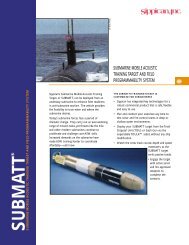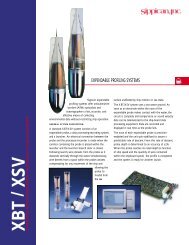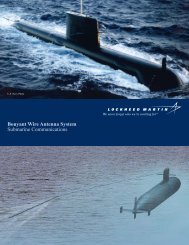Expendable Airlaunched Probes
Expendable Airlaunched Probes
Expendable Airlaunched Probes
You also want an ePaper? Increase the reach of your titles
YUMPU automatically turns print PDFs into web optimized ePapers that Google loves.
AIRCRAFT EXPENDABLE OCEANOGRAPHIC INSTRUMENTS<br />
AXCTD<br />
AXSV<br />
AXCP<br />
AIRCRAFT EXPENDABLE CONDUCTIVITY,<br />
TEMPERATURE, DEPTH PROFILER<br />
AIRCRAFT EXPENDABLE<br />
SOUND VELOCIMETER<br />
AIRCRAFT EXPENDABLE<br />
CURRENT PROFILER<br />
Conduct oceanographic surveys<br />
rapidly and economically with<br />
Sippican's family of aircraft expendable<br />
oceanographic instruments. Profiles of<br />
conductivity, temperature, sound<br />
velocity, and current velocity can be<br />
collected from aircraft at altitudes of<br />
up to 30,000 feet and launch speeds<br />
of up to 250 knots.The complete<br />
system consists of an expendable<br />
instrument housed in an "A" size<br />
sonobuoy, data acquisition system, RF<br />
receiver and antenna.<br />
SYSTEM DESCRIPTION<br />
Sippican's Aircraft <strong>Expendable</strong><br />
Oceanographic Instruments utilize the<br />
same probes as Sippican's Surface Ship<br />
and Submarine Launched Profilers<br />
which makes data intercomparisons<br />
from multiple platforms accurate and<br />
easy. On deployment from the aircraft,<br />
the buoy descends via parachute to<br />
the sea surface where the RF<br />
transmitter is activated.After a 42<br />
second delay, the surface buoy<br />
releases the probe and data collection<br />
begins.The data is transmitted on an<br />
FM signal from the surface unit to the<br />
RF receiver in the aircraft where the<br />
data is processed and displayed using<br />
Sippican's MK 12 and/or MK 10<br />
Oceanographic Data Acquisition<br />
Systems.The MK 12 accepts data from<br />
the AXCTD and AXSV while the MK 10<br />
is used exclusively with the AXCP.<br />
Both systems are IBM PC compatible<br />
and can be interfaced to the same<br />
computer to minimize the amount of<br />
equipment needed to be carried<br />
aboard the aircraft. If real time data<br />
processing is not required aboard the<br />
aircraft, the FM signal from the<br />
profiler can be recorded on audio<br />
tape and replayed through the data<br />
acquisition system back on the<br />
ground.At the completion of data<br />
transmission, the RF transmitter<br />
disables and the surface buoy scuttles.<br />
ocean systems division
Antenna<br />
Float Housing<br />
RF Transmitter<br />
Probe Specific Signal<br />
Conditioning PCB<br />
ocean systems division<br />
Probe<br />
Release Plate<br />
AXCTD<br />
float assembly<br />
AXCP<br />
float assembly<br />
An AXCTD profile<br />
PROBE SPECIFICATIONS<br />
PROBE PARAMETER DEPTH ACCURACY ACQUISITION<br />
SYSTEM<br />
AXCTD conductivity, temperature 1000 m -0.035 mS/cm,-0.035ºC MK 12<br />
AXSV sound velocity 850 m -0.025 m/sec MK 12<br />
AXCP current velocity, temperature 1500 m -1.0 cm/sec RMS,-0.2 ºC MK 10<br />
778SI 2 98<br />
7 Barnabas Road, Marion, MA 02738<br />
TEL (508) 748-1160<br />
FAX (508) 748-3626<br />
EMAIL oceansys@sippican.com<br />
WEB www.sippican.com<br />
Sippican is an ISO-9001 Certified Company
















